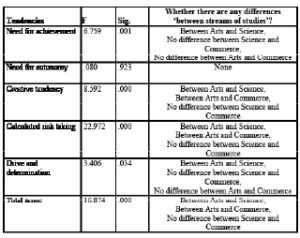
Abstract : The idea of entrepreneurship can be associated with different perceptions. Some understandings are related to what an entrepreneur does, and others to who the entrepreneur is. Entrepreneurship can be considered a factor of production. In contrast, others view the concept as a combination of factors of production, new products, and new methods, and some view risk-taking ability as the essence of entrepreneurial behaviour.
I. Introduction
Entrepreneurship can be observed as a temperament rather than a situational state or cultural role. This does not impair the impact of situational determinants, but that under related circumstances, some people will perform entrepreneurially while others will not. This implies that personality potential is a necessity for entrepreneurial behaviour. If personality characteristics and tendencies that affect entrepreneurial function can be appraised, they may indicate a bent towards or a potential of entrepreneurship (Lachman, 1980).
1.1 Enterprising Tendency
The enterprising tendency may be defined as the psychological characteristics associated with starting and running an enterprise. Entrepreneurship research has identified several personal factors believed to motivate entrepreneurial behaviour (Mueller & Thomas 2001).
Caird (1993) identified critical problems in the psychological testing of entrepreneurs that relate to varying definitions of the entrepreneur, numerous entrepreneurial characteristics, uncertainty about the significance of entrepreneurial tendencies, and lack of rigour in test development. She also highlighted that the results of well-validated tests showed many personality characteristics, which could be correlated with features of small firms and business owner‐managers.
1.2 General Enterprising Tendency (GET) Test
The General measure of Enterprising Tendency (GET) test was developed in 1988 by Sally Caird and Cliff Johnson at Durham University Business School. The test assumes that enterprise is a broader concept that includes more than just business owners, managers and entrepreneurs, recognising that there are different types of entrepreneurs, distinguished by their growth orientation, motivation, type of business, involvement with new technology, association with business owner management, and so on. The enterprising person may be an entrepreneur, or an ‘intrapreneur’, working within organisations, or the person who sets up and leads voluntary projects in the community.
The academic literature has different views on the entrepreneurial characteristics that are most important. The key entrepreneurial characteristics identified under the GET test include the need for achievement, autonomy, creative tendency, calculated risk-taking, and drive and determination.
The GET test is a self-assessment test that requires respondents to determine if they agree or disagree with statements designed to identify various aspects of their enterprising tendencies. The highest score (representing General Enterprising Tendency) is 54. A score between 44-54 means that the respondent is very enterprising (high enterprising tendency). GET score ranges between 27-43 means that the respondent has some enterprising qualities (medium enterprising tendency). A score suggests that the respondent is probably happiest working with guidance from superiors (low enterprising tendency).
II. Literature Review
Caird (1991) conducted a pilot study that aimed to measure key characteristics of enterprising people. The key characteristics include a high need for achievement, an increased need for autonomy, calculated risk-taking, an internal locus of control and a creative tendency.
Mueller & Thomas (2001) supported the proposition that some cultures are more conducive for entrepreneurship than others. In individualistic cultures, they found an increased likelihood of an internal locus of control orientation. They also reported that an entrepreneurial orientation, defined as internal locus of control combined with innovativeness, is more likely in individualistic, low uncertainty avoidance cultures than in collectivistic, high uncertainty avoidance cultures. They suggested that in addition to supporting from political, social, and business leaders, there needs to be a supportive culture to cultivate the mind and character of the potential entrepreneur.
In their study, Marcu, Iordanescu & Iordanescu (2012) focused on how perceptions of economic crisis and scarcity of money affect the entrepreneurial tendency of young people. It was found that the exposure of young people with an internal locus of control in crisis conditions significantly affects their entrepreneurial tendency. At the same time, the intensity of scarcity of money has an insignificant effect.
Holienka, Holienkova & Gal (2015) conducted a study to examine the entrepreneurial characteristics of university students in different disciplines. Their analysis provided evidence on different levels of overall enterprising tendency and particular entrepreneurial characteristics (namely need for achievement, calculated risk-taking and internal locus of control) between students with other majors. While business administration students exhibited the highest enterprising tendency, pedagogy students were found to be the least enterprising among the analysed fields of study.
Yao, Wu & Long (2016) explored the impact mechanism of Chinese university students’ perceived entrepreneurial environment on their entrepreneurial tendency in the context of Chinese economic transition. The study found that university students’ perceived social background and economic environment positively influence their entrepreneurial tendency, and entrepreneurial attitude partially plays a mediating role between students’ perceived entrepreneurial environment and entrepreneurial tendency.
Snow & Prater (2017) examined the entrepreneurial attitudes of high school seniors in Eastern Kentucky and their preferences to remain in or leave Eastern Kentucky. Their findings indicate that few students scored in the high level of enterprising tendency and the entrepreneurial characteristics of need for achievement, calculated risk-taking, and creative tendency. Findings also indicate that those with a high enterprising tendency are more likely to leave Eastern Kentucky for education and a career with no intention of returning.
Yildiz & Kartum (2017) examined the relationship between university students’ social status variables and entrepreneurship tendencies. As a result of the analysis, it is revealed that students are more control-oriented, but they lack tolerance to uncertainty. Participants’ entrepreneurship tendencies have significant differences in gender, education level, work experience, participation in any project and entrepreneurship competition, the idea of starting a business, the location of the region they come from, their father’s occupation and education level.
III. Objectives of the Study
The objective of the study focuses on these following issues
a) To determine the enterprising tendency scores of higher secondary school and college students in Aizawl, Mizoram, using the General Enterprising Tendency (GET) test.
b) To find out whether there are contrasting displays of GET among students considering gender, educational level and streams of study.
IV. Research Methodology
The study revolves around measuring enterprising tendency using General Enterprising Tendency (GET) test. It is conducted among higher secondary school students and undergraduate students studying arts, science and commerce subjects in various institutions within Aizawl, Mizoram, India.
Primary data is collected using a self-structured questionnaire is analysed using descriptive statistics. Inferential statistics like Pearson’s correlation, t-test and ANOVA are used wherever applicable. Secondary information is also collected from various sources like journals, books, websites, etc. The sample size is 752, drawn randomly from target population of study.
V. Analysis and Display of General Enterprising Tendency of Sample Respondents
The following observations were made from the responses made by sample respondents while following the prescribed processes involved in quantifying of GET scores.
Table 1: Over-all General Enterprising Tendency Score

As seen in Table 1, the mean general enterprising tendency score for students in Aizawl is 31.7437. The mean scores for achievement, need for autonomy, creative tendency, calculated risk-taking and drive and determination are below the standard average scores as prescribed by the GET process.
Gender based comparison was mapped to find out whether there is statistical difference between male and female with regards to GET scores. The following table demonstrates their comparative statistic.
Table 2: Gender wise GET scores

The above table shows that mean scores for the need for achievement, need for autonomy and drive and determination are relatively higher for female students than male students in Aizawl district.
However, the crux of inquiry lies whether this comparative difference is statistically significant or not between the sample genders.
A parametric t-test was run to observe any significant difference between genders for the tendencies. The results are as follows:
Table 3: Test of significant difference between genders

Table 3 revealed that there is a statistically significant difference between genders in risk-taking tendency. Since t is positive, the male respondents significantly score better than their female counterparts in risk-taking tendency.
The subsequent investigation was conducted between higher education students and collegiate students as independent samples to arrive whether these levels play significant role in differentiating GET scores.
A parametric t-test was run to observe any significant difference between levels of education for the tendencies. The results are as follows:
Table 4: Test of significant difference between levels of education

It was observed from Table 4 that there are no statistically significant differences between higher secondary school and college student respondents in their GET scores.
Another dimension of interest for survey would be whether different streams of study viz. arts, science and commerce play significant role in contrasting scores of GET among respondents.
A one-way ANOVA was run to observe whether there are any significant differences between streams of studies and GET scores.
Table 5: Test of significant difference between streams of education

Figures from Table 5 suggested that there is no statistically significant difference between Science and Commerce students in their enterprising tendency. However, Arts students are statistically different in their enterprising tendency when compared to Science and Commerce students in Aizawl. Its should be noted that appropriate post-hoc tests were conducted between each stream of study in case ANOVA turns out statistically significant.
VI. Conclusion
The enterprising tendency of Mizo youth in Aizawl, Mizoram, assessed using the GET test, reported a medium enterprising tendency. The mean enterprising tendency score of the student respondents is 31.7434, which is in the medium range of enterprising tendency. This mean score revealed that respondents are likely to have intensities in some of the enterprising characteristics and thus may be enterprising in some contexts. Male students have a higher mean enterprising tendency than female students and showed a statistically significant difference in their risk-taking ability. No significant difference is observed between higher secondary school students and college students in their enterprising characteristics. Science and commerce subject students displayed more vital enterprising tendencies compared to Arts subject students.
The present study assessed and measured the enterprising tendency of students and thus concluded that medium general enterprising tendency was observed. The basic premise of the GET test is that the enterprising person shares entrepreneurial characteristics and that these characteristics may be developed through education and training. Hence the study can be helpful for further research and as a tool for designing programmes, curriculums and drafting policies for promoting entrepreneurship development, especially in the state of Mizoram.
Works Cited
- Caird, S. (1991). Testing enterprising tendency in occupational groups. British Journal of Management, 2(4), 117-186.
- Caird, S. (1993). What do psychological tests suggest about entrepreneurs? Journal of Managerial Psychology, 8(6), 11- 20.
- Geri, S. (2013). Relationship between entrepreneurial skills and tendencies: A research on physical education students. International Journal of Business and Social Science, 4(5), 179-185.
- Holienka, M., Holienkova, J., & Gal, P. (2015). Entrepreneurial characteristics of students in different fields of study: A view from entrepreneurship education perspective. Acta Universitatis Agriculturae Et Silviculturae Mendelianae Brunensis, 63(6), 1879-1889.
- http://get2test.net/
- Lachman, R. (1980). Toward measurement of entrepreneurial tendencies. Management International Review, 20(2), 108- 116.
- Marcu, G., Iordanescu, C., & Iordanescu, E. (2012). The influence of the psychological factors upon the entrepreneurial tendency in crisis environments. Procedia – Social and Behavioural Sciences, 33(2012), 473-477.
- Mueller, S.L., & Thomas, A.S. (2001). Culture and entrepreneurial potential: A nine country study of locus of control and innovativeness. Journal of Business Venturing, 16(1), 51-75.
- Snow, D., & Prater, J. (2017). Entrepreneurship elsewhere: Examining the entrepreneurial characteristics of eastern Kentucky adolescents. Small Business Institute Journal, 13(2), 1-14.
- Sui, F.M., Chang, J.C.,Hsiao, H.C., & Su, S.C. (2017). A study on entrepreneurial education regarding college students’ creative tendency, entrepreneurship self-efficacy and entrepreneurial motivation. IEEE International Conference on Industrial Engineering and Engineering Management (IEEM), Singapore, 2017, 850-854.
- Yao, X., Wu, X., & Long, D. (2016). University students’ entrepreneurial tendency in China. Journal of Entrepreneurship in Emerging Economies, 8(1), 60-81.
- Yildiz, A., & Kartum, G. (2017). Examination of entrepreneurship tendencies within the context of social status variables: A practice on university students. The Journal of International Social Research, 10(50), 822-832.
Cite the original source:
Laldinliana. “Profiling General Enterprising Tendencies Among Higher Secondary and Collegiate Students in Aizawl (Mizoram).” Mizo Studies, X, no. 4, Dec. 2021, pp. 755–764.
![]()






